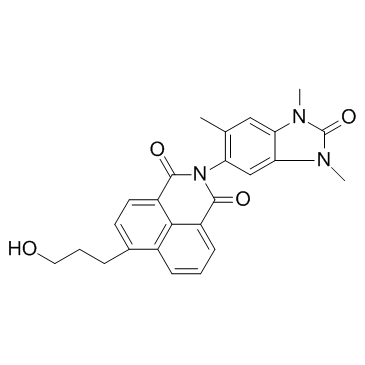BAY-299
Modify Date: 2025-08-25 21:31:30

BAY-299 structure
|
Common Name | BAY-299 | ||
|---|---|---|---|---|
| CAS Number | 2080306-23-4 | Molecular Weight | 429.468 | |
| Density | 1.4±0.1 g/cm3 | Boiling Point | 688.7±55.0 °C at 760 mmHg | |
| Molecular Formula | C25H23N3O4 | Melting Point | N/A | |
| MSDS | N/A | Flash Point | 370.3±31.5 °C | |
Use of BAY-299BAY-299 is a very potent, dual inhibitor with IC50s of 67 nM for BRPF2 bromodomains (BD), 8 nM for TAF1 BD2, and 106 nM for TAF1L BD2. |
| Name | 6-(3-Hydroxypropyl)-2-(1,3,6-trimethyl-2-oxo-2,3-dihydro-1H-benzimidazol-5-yl)-1H-benzo[de]isoquinoline-1,3(2H)-dione |
|---|---|
| Synonym | More Synonyms |
| Description | BAY-299 is a very potent, dual inhibitor with IC50s of 67 nM for BRPF2 bromodomains (BD), 8 nM for TAF1 BD2, and 106 nM for TAF1L BD2. |
|---|---|
| Related Catalog | |
| Target |
BRPF2 BD:67 nM (IC50) BRPF1 BD:3150 nM (IC50) BRPF3 BD:5550 nM (IC50) TAF1 BD2:8 nM (IC50) TAF1L BD2:106 nM (IC50) |
| In Vitro | BAY-299 is a dual inhibitor of the bromodomain and PHD finger (BRPF) family member BRPF2 and the TATA box binding protein-associated factors TAF1 and TAF1L. TR-FRET assays showed that BAY-299 is a potent inhibitor of BRPF2 BD with an IC50 of 67 nM, and a selectivity of 47- and 83-fold over BRPF1 and BRPF3 BDs. The profile of BAY-299 is further confirmed by AlphaScreen assay, where an IC50 of 97 nM and a selectivity of 23- and 25-fold over BRPF1 and BRPF3 BDs are measured. NanoBRET experiments show that the interaction of BRPF2 BD with histones H4 and H3.3 is blocked by BAY-299 with IC50 values of 575 and 825 nM, respectively. For TAF1 BD2, the IC50 values are 970 and 1400 nM, respectively. No inhibitory effect is observed for the interaction between BRPF1 or BRD4 and histone H4 up to 10 μM for BAY-299. BAY-299 inhibits MOLM-13, MV4-11, 769-P, Jurkat, NCI-H526, CHL-1, and 5637 cells proliferation with GI50s of 1060, 2630, 3210, 3900, 6860, 7400, and 7980 nM, respectively[1]. |
| In Vivo | Studies of the in vivo pharmacokinetic properties of BAY-299 in rat reveal that blood clearance is low (ca. 17% of hepatic blood flow), volume of distribution in steady-state high, terminal half-life long to very long (t1/2=10 h), and bioavailability high (F=73%). In vivo blood clearance is as anticipated based on rat liver microsome values but lower than expected based on hepatocyte data[1]. |
| Cell Assay | MOLM-13, MV4-11, 769-P, Jurkat, NCI-H526, CHL-1, and 5637 cell lines are treated with BAY-299 while in the logarithmic growth phase, and their viability is determined by AlamarBlue staining[1]. |
| Animal Admin | Rats[1] BAY-299 is administered to three male Wistar rats per arm, either intravenously or intragastrally formulated as solutions. BAY-299 is given as i.v. bolus, and blood samples are taken at 2 min, 8 min, 15 min, 30 min, 45 min, 1 h, 2 h, 4 h, 6 h, 8 h, and 24 h after dosing. For pharmacokinetics after intragastral administration, BAY-299 is given intragastrally to fasted rats and blood samples are taken at 5 min, 15 min, 30 min, 45 min, 1 h, 2 h, 4 h, 6 h, 8 h, and 24 h after dosing. Blood is collected into lithium-heparin tubes and centrifuged for 15 min at 3000 rpm[1]. |
| References |
| Density | 1.4±0.1 g/cm3 |
|---|---|
| Boiling Point | 688.7±55.0 °C at 760 mmHg |
| Molecular Formula | C25H23N3O4 |
| Molecular Weight | 429.468 |
| Flash Point | 370.3±31.5 °C |
| Exact Mass | 429.168854 |
| LogP | 2.30 |
| Vapour Pressure | 0.0±2.3 mmHg at 25°C |
| Index of Refraction | 1.697 |
| Storage condition | 2-8℃ |
| 6-(3-Hydroxypropyl)-2-(1,3,6-trimethyl-2-oxo-2,3-dihydro-1H-benzimidazol-5-yl)-1H-benzo[de]isoquinoline-1,3(2H)-dione |
| 1H-Benz[de]isoquinoline-1,3(2H)-dione, 2-(2,3-dihydro-1,3,6-trimethyl-2-oxo-1H-benzimidazol-5-yl)-6-(3-hydroxypropyl)- |
| BAY-299 |